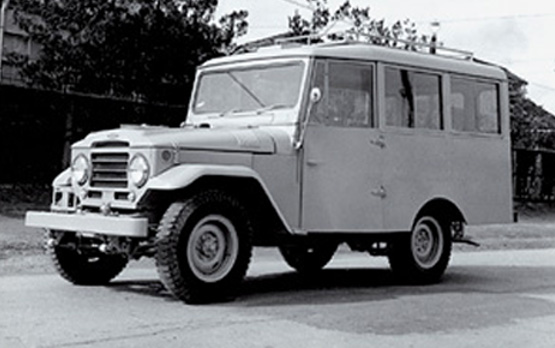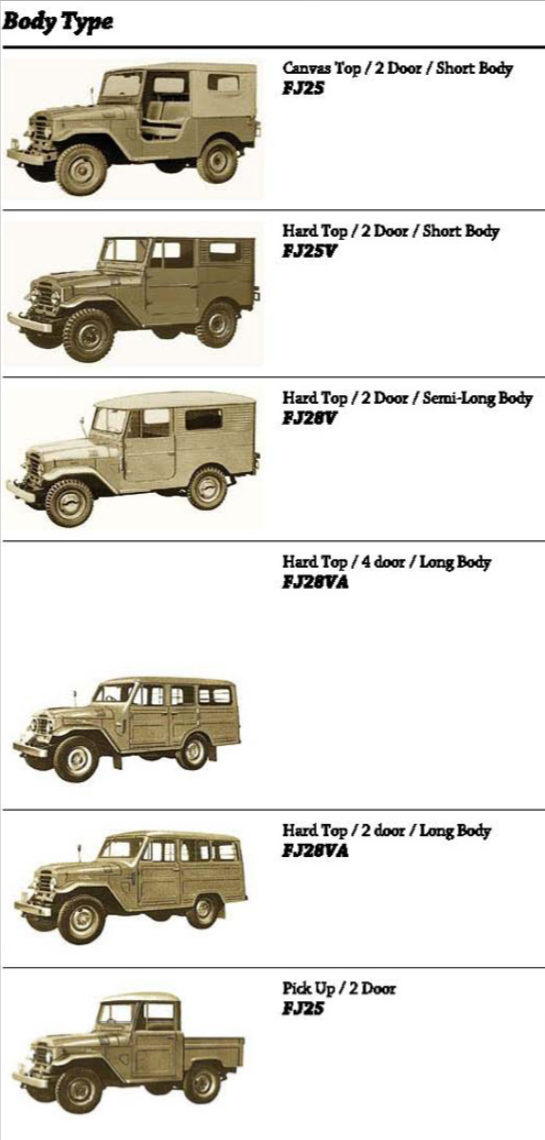
Since just right after Japan’s recovery from the war and its aftermath, Toyota already had future visions to export its domestic vehicles overseas. These forward-thinking Toyota employees knew just how important the Land Cruiser was to take this large step forward into further making their dreams a reality.
The Toyota Crown was first released in Japan in the mid-1950s when Toyota was working fast to build a domestic sales network to handle the demand. It was in such circumstances that from 1956 on, as part of Toyota’s strategy the company decided on what was called the Land Cruiser strategy for foreign markets. Given the fact that its performance could hold its own against rival models such as the Willys Jeep and Land Rover, Toyota decided it was the right time to expand in foreign markets, and whenever the opportunity presented itself Toyota was there with the Land Cruiser right out front. The Land Cruiser helped Toyota establish a bridgehead, and the idea was to follow with sales of passenger cars.
In this way with expansion into foreign markets, Toyota gained competitive strength by making the necessary changes and improvements through model changes, thereby effectively extending its export sales channels. Whereas the BJ-type Land Cruiser was originally built for military use, its design in time was modified to serve industrial expansion in peacetime, partly for the purpose of stimulating domestic demand for Toyota vehicles. Then in 1955, alongside production of the BJ-type Land Cruiser the 20-series made its debut.
At first, the B-type engine that was installed in the BJ25 was produced alongside the F-type gasoline engine (3,878cc, 105HP) that went into the FJ25, for which the prototype had been completed in 1948. When the B-type engine was phased out of production, leaving only the FJ-type. The wheelbase on this chassis was made a bit shorter, and the drive power improved, the 3-plate springs were replaced by 4-plate springs developed for the Crown (the BJ-type Land Cruiser had 9-plates), thereby making it a more comfortable ride.
The FJ25 was positioned as the standard of the FJ20-series for the domestic market, but in all there were 10 variations available from FJ20 through FJ29. There were two variations on the wheelbase, 2,285mm and 2,430mm, and along with the FJ26, 27, 29, and others, there was also the 4×2 Land Cruiser made for the National Police Agency. In 1958 the wheelbase was extended to 2,650mm, and a van body FJ35V was introduced.
After the increase of demand during the Korean War, Japanese automakers were invited to bid to meet further demand for military vehicles by supplying the U.S. Army Procurement Agency in Japan (APA). For this reason, in 1957, test vehicles supplied by Toyota, Nissan, Isuzu, and Mitsubishi, ranging from compact to large-sized trucks were gathered at the Aberdeen proving ground on the outskirts of Baltimore, Maryland for a comparative test run. This test was overseen by Toyota Chief Engineers Inagawa and Iritani. The result of the test run was that the Toyota 750kg capacity truck (2FQ15L) and the 2.5-ton capacity diesel truck (2DW15L) were adopted for procurement.
The performance of the FJ25L was not bad, but unfortunately it was fated to not be selected for procurement. However, by this time the superiority of the Land Cruiser had been acknowledged by the U.S. military, and as a confidence builder, this was all that was needed to convince Toyota that the time was right to expand in the American market.
The development theme for the 20-series was a new style with more driving comfort. As a result, it didn’t have much in common with the Toyota BJ, instead showing more soft lines in the body styling. These major changes in the chassis frame created a basic design, which through the transition to the 40-series remained unchanged for 29 years.
To improve the riding comfort first the springs in the suspension were changed. The leaf springs in the front and rear were lengthened and the number of plates reduced to 4 to create a softer cushion. In addition, rubber bushings were added to the pivot and shackle in order to dampen the vibration transmitted to the cabin. More vibrations from the suspension would be absorbed rather than transmitted to the body, if the inner channel of the side frame was extended, and the number of closed structure members was increased. The frame itself was strengthened so that the vibrations from the suspension would be absorbed rather than transmitted to the body.
Along with greater riding comfort, the interior of the vehicle was also made more comfortable. It was larger for one thing, and by remounting the engine 120mm forward the cabin could be extended by 200mm. The steering column was moved 10mm to the outside, which also gave more width and spaciousness to the cabin. These changes made it possible to move the parking brake lever from where it was on the passenger seat side in the Toyota BJ to a new position closer to the driver’s seat. This was an improvement in operability as well.
From the earliest models of the 20-series, the engine, transmission, transfer, and even the final drive gear were all basically the same unit throughout. Minor changes were made in the gear ratios of the 1st and 2nd gears favoring high speed driving, and a synchromesh mechanism was added to the 3rd and 4th gears. At the time synchromesh transmissions were being added rapidly not only to passenger cars but also to trucks. With these changes the 20-series was made available in 2 types, a short wheelbase of 2,285mm and a long wheelbase of 2,430mm. Compared to the 2,400mm of the Jeep BJ, the short version had improved maneuverability, and while the long version was only slightly longer it had a higher loading capacity. Using just these two chassis, from the BJ to the FJ, the 20-series went through a number of body variations.

- The FJ35V was a long wheelbase version using the body and chassis form the 20-series, and is the original base model that eventually developed into the Land Cruiser 100 today. It was sold only from February to August of 1960, however it was produced by Gifu Auto Body Industries until December of that year.
- The FJ28V has a wheelbase that is 145mm longer than that of the FJ25. This model also comes with a 3rd seat that was installed in the luggage area. The roof is made of steel, with reinforced plates on the inside. The window area is rather small.


You must be logged in to post a comment.